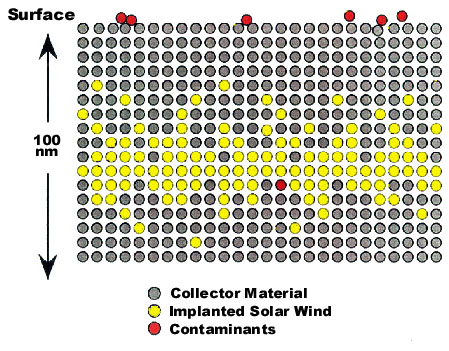Genesis Contamination Control Planning
Contamination control is a keystone for extraterrestrial sample curation and it begins when a mission is conceived and follows throughout sample curation. Genesis contamination control was incorporated into mission design and the details of hardware fabrication. JSC Genesis team provided modeling and assessment of spacecraft outgassing and station-keeping thruster exhaust contamination to the collector plates, analyzed and tested the contamination associated with micrometeoroid impacts, wrote the mission contamination control plan, and constructed two Class 10 rooms in which to process the spacecraft collection surfaces and sample canister.
Contamination exists in two forms: 1) particulate material, such as dust and flakes, from ground-handling and re-pressurization of the spacecraft after re-entry; and 2) molecular film from ground handling, spacecraft outgassing, station-keeping thrusters, and micrometeoroid impact vaporization. Tests have revealed that most contaminants will adhere to the first few nanometers of collector surface. However, since the solar wind particles are traveling hundreds of kilometers per second, atoms and ions from the solar wind will embed themselves in the top 100 nanometers of collector material—deep enough to differentiate the solar particles from superficial contamination from the spacecraft.

Figure showing the relationship of solar wind atoms and contaminants on collector material
JSC's contamination control strategy is a simple 4-step process:
- Start with clean collector materials.
- Minimize surface contamination until sample received for analysis.
- Clean the surface, if necessary, prior to analysis.
- Use analytical techniques that provide depth resolution.
The following table contains a list of some of the contamination sources identified and the pre-recovery strategy used to control the contamination.
| Contamination Source |
Strategy |
|---|---|
| Ground Handling |
|
| Outgassing |
|
| Micrometeoroid Impacts |
|
| Station-Keeping Thrusters |
|
| Re-entry re- pressurization |
|
